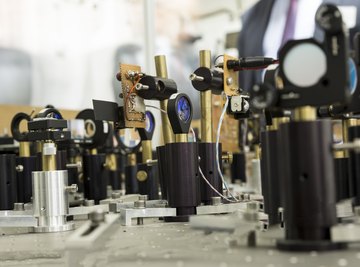
Quantum numbers are values that describe the energy or energetic state of an atom’s electron. The numbers indicate an electron’s spin, energy, magnetic moment and angular moment. According to Purdue University, quantum numbers come from the Bohr model, Schrödinger’s Hw = Ew wave equation, Hund’s rules and the Hund-Mulliken orbital theory. To understand the quantum numbers that describe the electrons in an atom, it's helpful to be familiar with the related physics and chemistry terms and principles.
Principal Quantum Number
Electrons spin in atomic shells called orbitals. Characterized by “n,” the principal quantum number identifies the distance from the nucleus of an atom to an electron, the size of the orbital and the azimuthal angular momentum, which is the second quantum number represented by "ℓ." The principal quantum number also describes the energy of an orbital as electrons are in a constant state of motion, have opposite charges, and are attracted to the nucleus. Orbitals where n=1 are closer to the nucleus of an atom than those where n=2 or a higher number. When n=1, an electron is in a ground state. When n=2, the orbitals are in an excited state.
Angular Quantum Number
Represented by “ℓ,” the angular, or azimuthal, quantum number identifies the shape of an orbital. It also tells you which suborbital, or atomic shell layer, you can find an electron in. Purdue University says that orbitals can have spherical shapes where ℓ=0, polar shapes where ℓ=1 and cloverleaf shapes where ℓ=2. A cloverleaf shape that has an extra petal is defined by ℓ=3. Orbitals can have more complex shapes with additional petals. Angular quantum numbers can have any integer between 0 and n-1 to describe the shape of an orbital. When there are sub-orbitals, or sub-shells, a letter represents each type: “s” for ℓ=0, “p” for ℓ=1, “d” for ℓ=2 and “f” for ℓ=3. Orbitals can have more sub-shells that result in a larger angular quantum number. The greater the value of the sub-shell, the more energized it is. When ℓ=1 and n=2, the sub-shell is 2p as the number 2 represents the principal quantum number and p represents the sub-shell.
Magnetic Quantum Number
The magnetic quantum number, or "m," describes an orbital’s orientation based in its shape (ℓ) and energy (n). In equations, you'll see the magnetic quantum number characterized by the lowercase letter M with a subscript ℓ, m_{ℓ}, which tells you the orientation of the orbitals within a sub-level. Purdue University states that you need the magnetic quantum number for any shape that isn't a sphere, where ℓ=0, because spheres only have one orientation. On the other hand, the "petals" of an orbital with a cloverleaf or polar shape can face different directions, and the magnetic quantum number tells which way they face. Instead of having consecutive positive integral numbers, a magnetic quantum number can have integral values of -2, -1, 0, +1 or +2. These values split sub-shells into individual orbitals that carry the electrons. In addition, each sub-shell has 2ℓ+1 orbitals. Therefore, sub-shell s, which equals the angular quantum number 0, has one orbital: (2x0)+1=1. Sub-shell d, which equals the angular quantum number 2, would have five orbitals: (2x2)+1=5.
Spin Quantum Number
The Pauli Exclusion Principle says that no two electrons can have the same n, ℓ, m or s values. Therefore, only a maximum of two electrons can be in the same orbital. When there are two electrons in the same orbital, they must spin in opposite directions, as they create a magnetic field. The spin quantum number, or s, is the direction that an electron spins. In an equation, you may see this number represented by a lowercase m and a subscript lowercase letter s, or m_{s}. Since an electron can only spin in one of two directions -- clockwise or counterclockwise -- the numbers that represent s are +1/2 or -1/2. Scientists may refer to the spin as "up" when it's counter clockwise, which means the spin quantum number is +1/2. When the spin is "down," it has an m_{s} value of -1/2.
References
About the Author
Flora Richards-Gustafson has been writing professionally since 2003. She creates copy for websites, marketing materials and printed publications. Richards-Gustafson specializes in SEO and writing about small-business strategies, health and beauty, interior design, emergency preparedness and education. Richards-Gustafson received a Bachelor of Arts from George Fox University in 2003 and was recognized by Cambridge's "Who's Who" in 2009 as a leading woman entrepreneur.
